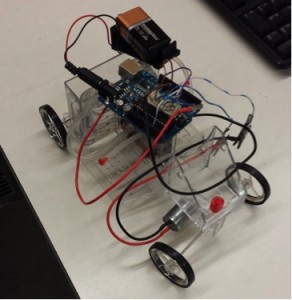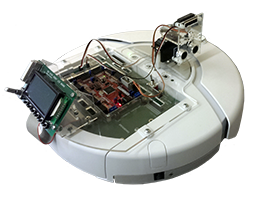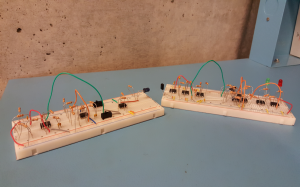Electrical Engineering Projects
Senior Design -Fall 2017
I am currently part of a six-member team who are designing and implementing a small scale stand-alone hybrid solar PV and wind energy generation system. Our current plans are to have four one hundred watt solar panels and one three hundred and fifty-watt wind turbine. The idea of this project is to understand and evaluate the possibilities of generating energy and storing it for a given load away from the grid. Currently I am researching possible vertical wind turbines that we can install on our campus to use in our project.
Mars Roomba – Spring 2016
For the final project in Embedded Systems I programed an ATmega128 microcontroller to modify a Rommba vacuum. The goal of the project was to have the robot run an obstacle course “on mars” filled with ravines, large rocks, and sharp cliff walls. My team of four students learned how to use the onboard bump, sonar, infrared, and cliff sensors to find a desired end location. We created a graphical interface with the robot and were able to track where our robot had been, what obstacles were in the way, and where we need to go next. Using bluetooth to communicate with our robot we were able to send it commands from “earth”. Our team had mission success when we were able to complete the obstacle course while only using the data collected from the robot to guide our path to the end goal.
Infrared Transmitter and Receiver – Spring 2015
As a project in my Circuits II class a group of students and I designed a device that either turns on a red LED or green LED, based off of a user input. The device is comprised of two circuits: the first one transmits a signal of varying frequencies through an infrared LED, and the other takes that signal and amplifiers it so that we can light up the designated LED for that frequency. The transmitting circuit has two oscillators, an amplifier and an infrared transmitter. The receiving circuit is comprised of an infrared receiver, bandpass filters, full-wave rectifiers, and comparator circuits for each of the different frequencies that need to be transmitted. In the end our project worked like a tv remote. We were able to turn on one switch and have the corresponding led light up.
Hydro Electric Hybrid Car – Fall 2014

Hybrid Hydroelectric Car
This project started with a toy car that I had received that performed electrolysis using a hydrogen fuel cell to split water into hydrogen and oxygen while hooked up to a power supply. The hydrogen and oxygen were then stored two separate tanks. The car was then removed from the power supply and it started to recombine the hydrogen and oxygen to create energy to move the car. I took this car and made it into a hybrid by adding a battery controlled Arduino microcontroller onto the car. Now the car runs on recombination of oxygen and water until it runs out and then the battery takes over and runs the car and splits the water that had reformed back into hydrogen and oxygen. While creating my hybrid I had to learn how to write Arduino code, use a transistor as a switch, and solder components into a board; none of which I had done before.



